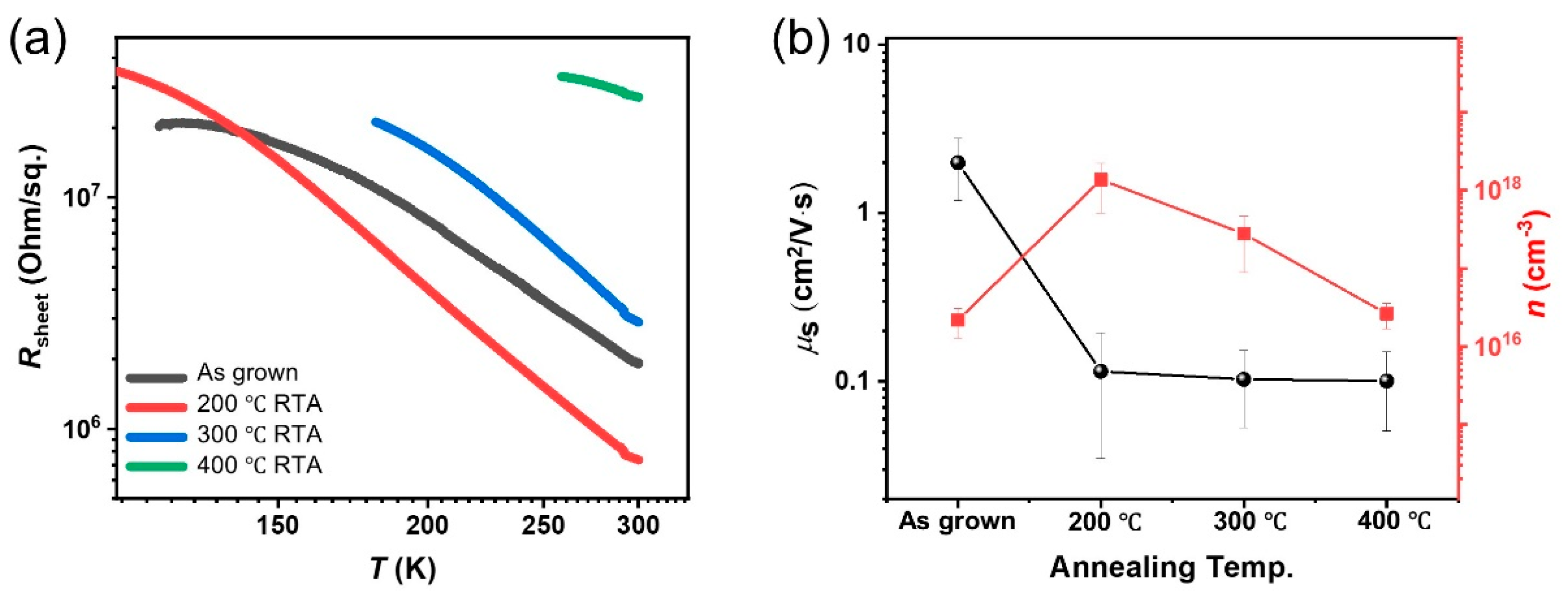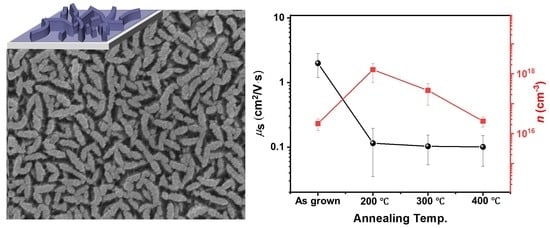Electrical Properties and Thermal Annealing Effects of Polycrystalline MoS2-MoSX Nanowalls Grown by Sputtering Deposition Method
Abstract
1. Introduction
2. Materials and Methods
2.1. MoS2 Nanowall Growth
2.2. Characterization of the MoS2 Nanowalls
3. Results and Discussion
4. Conclusions
Supplementary Materials
Author Contributions
Funding
Institutional Review Board Statement
Informed Consent Statement
Data Availability Statement
Conflicts of Interest
References
- Wang, H.; Yuan, H.; Sae Hong, S.; Li, Y.; Cui, Y. Physical and chemical tuning of two-dimensional transition metal dichalcogenides. Chem. Soc. Rev. 2015, 44, 2664–2680. [Google Scholar] [CrossRef] [PubMed]
- Ryder, C.R.; Wood, J.D.; Wells, S.A.; Hersam, M.C. Chemically Tailoring Semiconducting Two-Dimensional Transition Metal Dichalcogenides and Black Phosphorus. ACS Nano 2016, 10, 3900–3917. [Google Scholar] [CrossRef]
- Lv, R.; Robinson, J.A.; Schaak, R.E.; Sun, D.; Sun, Y.; Mallouk, T.E.; Terrones, M. Transition metal dichalcogenides and beyond: Synthesis, properties, and applications of single- and few-layer nanosheets. Acc. Chem. Res. 2015, 48, 56–64. [Google Scholar] [CrossRef] [PubMed]
- Costanzo, D.; Jo, S.; Berger, H.; Morpurgo, A.F. Gate-induced superconductivity in atomically thin MoS2 crystals. Nat. Nanotechnol. 2016, 11, 339–344. [Google Scholar] [CrossRef]
- Hussain, S.; Shehzad, M.A.; Vikraman, D.; Khan, M.F.; Singh, J.; Choi, D.C.; Seo, Y.; Eom, J.; Lee, W.G.; Jung, J. Synthesis and characterization of large-area and continuous MoS2 atomic layers by RF magnetron sputtering. Nanoscale 2016, 8, 4340–4347. [Google Scholar] [CrossRef] [PubMed]
- Hussain, S.; Singh, J.; Vikraman, D.; Singh, A.K.; Iqbal, M.Z.; Khan, M.F.; Kumar, P.; Choi, D.C.; Song, W.; An, K.S.; et al. Large-area, continuous and high electrical performances of bilayer to few layers MoS2 fabricated by RF sputtering via post-deposition annealing method. Sci. Rep. 2016, 6, 30791. [Google Scholar] [CrossRef]
- Wang, Y.; Wang, S.; Li, C.; Qian, M.; Bu, J.; Wang, J.; Huang, R. Facile growth of well-dispersed and ultra-small MoS2 nanodots in ordered mesoporous silica nanoparticles. Chem. Commun. 2016, 52, 10217–10220. [Google Scholar] [CrossRef]
- Kalanyan, B.; Kimes, W.A.; Beams, R.; Stranick, S.J.; Garratt, E.; Kalish, I.; Davydov, A.V.; Kanjolia, R.K.; Maslar, J.E. Rapid Wafer-Scale Growth of Polycrystalline 2H-MoS2 by Pulsed Metalorganic Chemical Vapor Deposition. Chem. Mater. 2017, 29, 6279–6288. [Google Scholar] [CrossRef]
- Hu, C.; Jiang, Z.; Zhou, W.; Guo, M.; Yu, T.; Luo, X.; Yuan, C. Wafer-Scale Sulfur Vacancy-Rich Monolayer MoS2 for Massive Hydrogen Production. J. Phys. Chem. Lett. 2019, 10, 4763–4768. [Google Scholar] [CrossRef]
- Kim, Y.; Bark, H.; Kang, B.; Lee, C. Wafer-Scale Substitutional Doping of Monolayer MoS2 Films for High-Performance Optoelectronic Devices. ACS Appl. Mater. Interfaces 2019, 11, 12613–12621. [Google Scholar] [CrossRef]
- Krishnan, U.; Kaur, M.; Singh, K.; Kumar, M.; Kumar, A. A synoptic review of MoS2: Synthesis to applications. Superlattices Microstruct. 2019, 128, 274–297. [Google Scholar] [CrossRef]
- Song, B.; Gu, H.; Fang, M.; Chen, X.; Jiang, H.; Wang, R.; Zhai, T.; Ho, Y.-T.; Liu, S. Layer-Dependent Dielectric Function of Wafer-Scale 2D MoS2. Adv. Opt. Mater. 2019, 7, 1801250. [Google Scholar] [CrossRef]
- Sharma, A.; Mahlouji, R.; Wu, L.; Verheijen, M.A.; Vandalon, V.; Balasubramanyam, S.; Hofmann, J.P.; Erwin Kessels, W.M.M.; Bol, A.A. Large area, patterned growth of 2D MoS2 and lateral MoS2-WS2 heterostructures for nano- and opto-electronic applications. Nanotechnology 2020, 31, 255603. [Google Scholar] [CrossRef] [PubMed]
- Yoo, C.; Kaium, M.G.; Hurtado, L.; Li, H.; Rassay, S.; Ma, J.; Ko, T.J.; Han, S.S.; Shawkat, M.S.; Oh, K.H.; et al. Wafer-Scale Two-Dimensional MoS2 Layers Integrated on Cellulose Substrates Toward Environmentally Friendly Transient Electronic Devices. ACS Appl. Mater. Interfaces 2020, 12, 25200–25210. [Google Scholar] [CrossRef]
- Sari, F.N.I.; Ting, J.M. Direct Growth of MoS2 Nanowalls on Carbon Nanofibers for Use in Supercapacitor. Sci. Rep. 2017, 7, 5999. [Google Scholar] [CrossRef] [PubMed]
- Alexaki, K.; Kostopoulou, A.; Sygletou, M.; Kenanakis, G.; Stratakis, E. Unveiling the Structure of MoSx Nanocrystals Produced upon Laser Fragmentation of MoS2 Platelets. ACS Omega 2018, 3, 16728–16734. [Google Scholar] [CrossRef]
- Sreedhara, M.B.; Gope, S.; Vishal, B.; Datta, R.; Bhattacharyya, A.J.; Rao, C.N.R. Atomic layer deposition of crystalline epitaxial MoS2 nanowall networks exhibiting superior performance in thin-film rechargeable Na-ion batteries. J. Mater. Chem. A 2018, 6, 2302–2310. [Google Scholar] [CrossRef]
- Nawz, T.; Safdar, A.; Hussain, M.; Sung Lee, D.; Siyar, M. Graphene to Advanced MoS2: A Review of Structure, Synthesis, and Optoelectronic Device Application. Crystals 2020, 10, 902. [Google Scholar] [CrossRef]
- Yu, B.; Chen, Y.; Wang, Z.; Chen, D.; Wang, X.; Zhang, W.; He, J.; He, W. 1T-MoS2 nanotubes wrapped with N-doped graphene as highly-efficient absorbent and electrocatalyst for Li–S batteries. J. Power Sources 2020, 447, 227364. [Google Scholar] [CrossRef]
- Yang, P.; Zhang, Z.; Sun, M.; Lin, F.; Cheng, T.; Shi, J.; Xie, C.; Shi, Y.; Jiang, S.; Huan, Y.; et al. Thickness Tunable Wedding-Cake-like MoS2 Flakes for High-Performance Optoelectronics. ACS Nano 2019, 13, 3649–3658. [Google Scholar] [CrossRef]
- Kong, D.; Wang, H.; Cha, J.J.; Pasta, M.; Koski, K.J.; Yao, J.; Cui, Y. Synthesis of MoS2 and MoSe2 films with vertically aligned layers. Nano Lett. 2013, 13, 1341–1347. [Google Scholar] [CrossRef] [PubMed]
- Lin, Z.Y.; Liu, Y.; Halim, U.; Ding, M.N.; Liu, Y.Y.; Wang, Y.L.; Jia, C.C.; Chen, P.; Duan, X.D.; Wang, C.; et al. Solution-processable 2D semiconductors for high-performance large-area electronics. Nature 2018, 562, 254–258. [Google Scholar] [CrossRef]
- Kim, S.; Konar, A.; Hwang, W.S.; Lee, J.H.; Lee, J.; Yang, J.; Jung, C.; Kim, H.; Yoo, J.B.; Choi, J.Y.; et al. High-mobility and low-power thin-film transistors based on multilayer MoS2 crystals. Nat. Commun. 2012, 3, 1–7. [Google Scholar] [CrossRef]
- Chang, H.Y.; Yogeesh, M.N.; Ghosh, R.; Rai, A.; Sanne, A.; Yang, S.X.; Lu, N.S.; Banerjee, S.K.; Akinwande, D. Large-Area Monolayer MoS2 for Flexible Low-Power RF Nanoelectronics in the GHz Regime. Adv. Mater. 2016, 28, 1818–1823. [Google Scholar] [CrossRef]
- Bertolazzi, S.; Krasnozhon, D.; Kis, A. Nonvolatile Memory Cells Based on MoS2/Graphene Heterostructures. ACS Nano 2013, 7, 3246–3252. [Google Scholar] [CrossRef]
- Tao, J.G.; Chai, J.W.; Lu, X.; Wong, L.M.; Wong, T.I.; Pan, J.S.; Xiong, Q.H.; Chi, D.Z.; Wang, S.J. Growth of wafer-scale MoS2 monolayer by magnetron sputtering. Nanoscale 2015, 7, 2497–2503. [Google Scholar] [CrossRef]
- Chen, C.-A.; Lee, C.-L.; Yang, P.-K.; Tsai, D.-S.; Lee, C.-P. Active Site Engineering on Two-Dimensional-Layered Transition Metal Dichalcogenides for Electrochemical Energy Applications: A Mini-Review. Catalysts 2021, 11, 151. [Google Scholar] [CrossRef]
- Nalwa, H.S. A review of molybdenum disulfide (MoS2) based photodetectors: From ultra-broadband, self-powered to flexible devices. Rsc Adv. 2020, 10, 30529–30602. [Google Scholar] [CrossRef]
- Wang, L.; Jie, J.S.; Shao, Z.B.; Zhang, Q.; Zhang, X.H.; Wang, Y.M.; Sun, Z.; Lee, S.T. MoS2/Si Heterojunction with Vertically Standing Layered Structure for Ultrafast, High-Detectivity, Self-Driven Visible-Near Infrared Photodetectors. Adv. Funct. Mater. 2015, 25, 2910–2919. [Google Scholar] [CrossRef]
- Um, D.S.; Lee, Y.; Lim, S.; Park, S.; Lee, H.; Koe, H. High-Performance MoS2/CuO Nanosheet-on-One-Dimensional Heterojunction Photodetectors. ACS Appl. Mater. Inter. 2016, 8, 33955–33962. [Google Scholar] [CrossRef]
- Kim, H.S.; Kumar, M.D.; Kim, J.; Lim, D. Vertical growth of MoS2 layers by sputtering method for efficient photoelectric application. Sens. Actuat. A-Phys. 2018, 269, 355–362. [Google Scholar] [CrossRef]
- Shao, Q.; Yu, G.; Lan, Y.W.; Shi, Y.; Li, M.Y.; Zheng, C.; Zhu, X.; Li, L.J.; Amiri, P.K.; Wang, K.L. Strong Rashba-Edelstein Effect-Induced Spin-Orbit Torques in Monolayer Transition Metal Dichalcogenide/Ferromagnet Bilayers. Nano Lett. 2016, 16, 7514–7520. [Google Scholar] [CrossRef]
- Zhang, W.; Sklenar, J.; Hsu, B.; Jiang, W.; Jungfleisch, M.B.; Xiao, J.; Fradin, F.Y.; Liu, Y.; Pearson, J.E.; Ketterson, J.B.; et al. Research Update: Spin transfer torques in permalloy on monolayer MoS2. APL Mater. 2016, 4, 032302. [Google Scholar] [CrossRef]
- Jie, W.; Yang, Z.; Zhang, F.; Bai, G.; Leung, C.W.; Hao, J. Observation of Room-Temperature Magnetoresistance in Monolayer MoS2 by Ferromagnetic Gating. ACS Nano 2017, 11, 6950–6958. [Google Scholar] [CrossRef] [PubMed]
- Zhou, J.; Qiao, J.; Duan, C.G.; Bournel, A.; Wang, K.L.; Zhao, W. Large Tunneling Magnetoresistance in VSe2/MoS2 Magnetic Tunnel Junction. ACS Appl. Mater. Interfaces 2019, 11, 17647–17653. [Google Scholar] [CrossRef] [PubMed]
- Bai, S.L.; Chen, C.; Luo, R.X.; Chen, A.F.; Li, D.Q. Synthesis of MoO3/reduced graphene oxide hybrids and mechanism of enhancing H2S sensing performances. Sens. Actuat. B-Chem. 2015, 216, 113–120. [Google Scholar] [CrossRef]
- Liu, Y.; Feng, P.Z.; Wang, Z.; Jiao, X.Y.; Akhtar, F. Novel Fabrication and Enhanced Photocatalytic MB Degradation of Hierarchical Porous Monoliths of MoO3 Nanoplates. Sci. Rep. 2017, 7, 1845. [Google Scholar] [CrossRef]
- Liu, M.X.; Shi, J.P.; Li, Y.C.; Zhou, X.B.; Ma, D.L.; Qi, Y.; Zhang, Y.F.; Liu, Z.F. Temperature-Triggered Sulfur Vacancy Evolution in Monolayer MoS2/Graphene Heterostructures. Small 2017, 13, 1602967. [Google Scholar] [CrossRef]
- Ishihara, S.; Hibino, Y.; Sawamoto, N.; Suda, K.; Ohashi, T.; Matsuura, K.; Machida, H.; Ishikawa, M.; Sudoh, H.; Wakabayashi, H.; et al. Improving crystalline quality of sputtering-deposited MoS2 thin film by postdeposition sulfurization annealing using (t-C4H9)2S2. Jpn. J. Appl. Phys. 2016, 55, 04EJ07. [Google Scholar] [CrossRef]
- Li, H.; Zhang, Q.; Yap, C.C.R.; Tay, B.K.; Edwin, T.H.T.; Olivier, A.; Baillargeat, D. From Bulk to Monolayer MoS2: Evolution of Raman Scattering. Adv. Funct. Mater. 2012, 22, 1385–1390. [Google Scholar] [CrossRef]
- Murase, S.; Ogawa, R.; Saitoh, T.; Moriai, H.; Matsushita, T.; Osamura, K. Residual Resistance Ratio Measurement Method of Cu/Nb3Sn Composite Conductors; Springer: Tokyo, Japan, 2000; pp. 700–702. [Google Scholar]
- Charifoulline, Z. Residual Resistivity Ratio (RRR) Measurements of LHC Superconducting NbTi Cable Strands. IEEE Trans. Appl. Supercond. 2006, 16, 1188–1191. [Google Scholar] [CrossRef]
- Eisele, I.; Dorda, G. Negative Magnetoresistance in n-Channel (100) Silicon Inversion Layers. Phys. Rev. Lett. 1974, 32, 1360–1363. [Google Scholar] [CrossRef]
- Bishop, D.J.; Dynes, R.C.; Tsui, D.C. Magnetoresistance in Si metal-oxide-semiconductor field-effect transitors: Evidence of weak localization and correlation. Phys. Rev. B 1982, 26, 773–779. [Google Scholar] [CrossRef]
- Hishiyama, Y.; Kaburagi, Y.; Inagaki, M. Chapter 9—Magnetoresistance. In Materials Science and Engineering of Carbon; Inagaki, M., Kang, F., Eds.; Butterworth-Heinemann: Oxford, UK, 2016; pp. 173–204. [Google Scholar]
- Breunig, O.; Wang, Z.; Taskin, A.A.; Lux, J.; Rosch, A.; Ando, Y. Gigantic negative magnetoresistance in the bulk of a disordered topological insulator. Nat. Commun. 2017, 8, 15545. [Google Scholar] [CrossRef]






Publisher’s Note: MDPI stays neutral with regard to jurisdictional claims in published maps and institutional affiliations. |
© 2021 by the authors. Licensee MDPI, Basel, Switzerland. This article is an open access article distributed under the terms and conditions of the Creative Commons Attribution (CC BY) license (http://creativecommons.org/licenses/by/4.0/).
Share and Cite
Um, D.-S.; Jin, M.-J.; Woo, J.-C.; Kim, D.-P.; Park, J.; Jo, Y.; Kim, G.-H. Electrical Properties and Thermal Annealing Effects of Polycrystalline MoS2-MoSX Nanowalls Grown by Sputtering Deposition Method. Crystals 2021, 11, 351. https://doi.org/10.3390/cryst11040351
Um D-S, Jin M-J, Woo J-C, Kim D-P, Park J, Jo Y, Kim G-H. Electrical Properties and Thermal Annealing Effects of Polycrystalline MoS2-MoSX Nanowalls Grown by Sputtering Deposition Method. Crystals. 2021; 11(4):351. https://doi.org/10.3390/cryst11040351
Chicago/Turabian StyleUm, Doo-Seung, Mi-Jin Jin, Jong-Chang Woo, Dong-Pyo Kim, Jungmin Park, Younghun Jo, and Gwan-Ha Kim. 2021. "Electrical Properties and Thermal Annealing Effects of Polycrystalline MoS2-MoSX Nanowalls Grown by Sputtering Deposition Method" Crystals 11, no. 4: 351. https://doi.org/10.3390/cryst11040351
APA StyleUm, D.-S., Jin, M.-J., Woo, J.-C., Kim, D.-P., Park, J., Jo, Y., & Kim, G.-H. (2021). Electrical Properties and Thermal Annealing Effects of Polycrystalline MoS2-MoSX Nanowalls Grown by Sputtering Deposition Method. Crystals, 11(4), 351. https://doi.org/10.3390/cryst11040351








